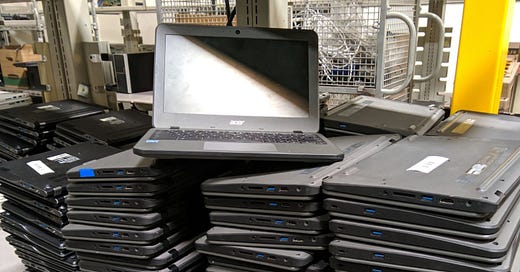Chromebook Churn could sink school budgets (and the planet)
The COVID pandemic put a Chromebook in the hands of almost every student. Three years later, they’re nearing the end of their support life, threatening schools with a tsunami of e-waste.
Chromebook churn could sink school budgets (and the planet)
The arrival of the COVID-19 pandemic pushed school districts across the world into a massive, uncontrolled experiment in distance learning. With in-person gathering discouraged, school districts rushed to purchase computers for their students - hundreds or thousands at a time, depending on the size of the district.
By and large, Chromebooks were the platform of choice. The inexpensive, light weight devices offered districts much of what they needed: a common software platform, and access to Internet-based applications for viewing lessons, email and chat and so on. Shipments of Chromebooks set records in 2020, reaching 11.2 million units in Q4 2020, a 287% increase over Q4 2019. In all, more than 30.6 million units were sold that year.
Three years later, however, many of those devices are nearing the end of their support. That may, in short order, force districts to discard perfectly functioning hardware and replace it for no other reason than that the manufacturer has made a business decision not to support it beyond a certain date.
As PIRG notes in a report this week on Chromebook “churn,” that has massive consequences for both cash-strapped local school districts and the planet. Two numbers stick out there: 1.8 billion and 900,000.
The first number, 1.8 billion, is the amount of money, measured in US Dollars, that school districts in the country would save if the lifespan of Chromebooks currently in use were doubled.
The second number, 900,000 represents the number of cars that would have to come off the road for an entire year to equal the amount of pollution that will be created to replace rather than (repair and) extend the life of the Chromebooks in use.
PIRG said the looming crisis around Chromebook replacement is largely avoidable. Chromebooks fall out of use because of an end of support date set by Google. Once laptops have exceeded their support life, they don’t receive updates and can’t access secure websites. For example, instructors have reported that expired laptops can’t access online state testing websites, PIRG reports.
The other issue is that manufacturers do not build Chromebooks to be repairable, with designs that frustrate repairs and few spare parts produced by manufacturers. As it stands, schools need to purchase parts from third-parties or scavenge them from broken machines to complete repairs. That scarcity can contribute to the high price for parts, making repair uneconomical.
Of the 11 Chromebooks PIRG reviewed, the average parts availability rating was 3.3 out of 20 (using the French repairability index). That’s much lower than the average non-Chromebook laptop, which averaged out to 9 out of 20.
PIRG has called on Google to extend the support of the Chrome OS software from the current average of about 4 years to 10 years or more. It has also called on hardware makers to make their devices more repairable: offering replacement parts and making design decisions that support repairability.
As the IoT balloons: a call to open-source firmware
Rupert Goodwins writes in the Register that firmware (the software that controls the behavior of electronic devices) should be open and unlocked, rather than closed and proprietary. Goodwins says locking down firmware creates more barriers than benefits for manufacturers, users, innovators, and the environment, and that open source firmware is theft-proof.
Estimates are that there will be 27.1 billion connected IoT devices by 2025 across countless parts of our lives (transportation, hospitals, agriculture, etc.)
In light of the growing population of connected devices, Goodwins believes closed firmware is an outdated concept and that manufacturers should publish the code and open the specs to create more innovation and extend the useful life of electronic devices.
Other News
Farm Groups Push Indiana, Other States to Follow Colorado’s Lead on ‘Right to Repair’ Bill - Now that lawmakers in Colorado have passed a bill that will allow farmers fix their own equipment, several farm groups are encouraging Indiana lawmakers to follow suit. “We feel like there’s a real fairness issue in agriculture. Farmers really need the right to fix their own stuff,” says Aaron Shier, government relations director for the National Farmers Union.
Massachusetts AG calls out opponents in case over repair telematics law Massachusetts new Attorney General Andrea Campbell is pushing ahead with her stated intention to enforce a November 2020 ballot measure to extend the state’s automobile right to repair law to include access to vehicle telematics data. In March, Campbell terminated a non-enforcement stipulation of the Data Access Law agreed to by former AG Maura Healey that had been in place since Dec. 3, 2020. “The remaining claims to be decided in this case are the Alliance’s preemption claims under the federal Motor Vehicle Safety Act (“MVSA”) and the federal Clean Air Act (“CAA”),” Campbell wrote in her April 14 brief. “The test for preemption is whether there is ‘no set of circumstances’ under which a party can comply with state law without violating federal law. Incredibly, the Alliance’s brief mentions neither the MVSA nor the CAA. It instead ruminates on purported ‘problems’ with the Data Access Law and difficulties its members will face in achieving ‘compliance’ with it. …Such concerns — even if they found support in the record, which they do not — fail to not support preemption.”
Tesla's 4680 battery is almost impossible to repair because of the pink potting material that prevents the individual cell connections from falling apart, making it less serviceable, according to Gruber Motor Company CEO Pete Gruber and Munro & Associates CEO Sandy Munro. Even with ways to perform battery pack surgery on a resistive cell without having to replace the entire battery pack, replacements can cost between $13,000 and $20,000, including labor.
Footwear made from synthetic materials contributes to climate change and ends up in landfills, prompting brands experiment with recyclable and natural materials in their shoes. Brands are using algae, bamboo, cork, sugarcane, eucalyptus and other natural materials to make shoes.
Customers are becoming increasingly skeptical of companies' sustainability claims and are demanding genuine efforts, not just greenwashing, with brands like Ganni stepping away from the use of the word “sustainability” to describe their companies. Fashion brand Ganni says they “don't identify as a sustainable brand, because at its core fashion thrives on newness and consumption, which is a major contradiction to the concept of sustainability.”
Right-to-repair law could mean cheaper fixes for products, legislators told a bill that would allow consumers to get their electronics and outdoor equipment repaired without relying on manufacturer-approved service vendors drew mixed reactions at a Maine legislative committee hearing Tuesday. Advocates of the legislation said it would let Mainers have equipment serviced at lower costs. But opponents said the measure would hurt businesses that have trained repair workers and also could expose the public to security or safety hazards.
Legislation pending in Vermont seeks to establish the "right to repair" agricultural and forestry equipment by requiring manufacturers to make parts, tools, and documentation available to equipment owners and independent repair shops on fair financial terms.
The right to repair movement emerges We predict that tensions between consumer rights organizations and manufacturers will continue to flare up, particularly over what is emerging as the most contentious issue – telematics.
In their attempt to maximize subscription revenue or limit long-term maintenance costs for obsolete products, many manufacturers are doing a fantastic job of generating the worst kind of bad publicity when it comes to their cringeworthy telematics policies.
Improving the ecological health of benefits hard infrastructure such as asphalt roads—according to a study in Parkland County, Alberta. Research that spending strategically on "green infrastructure" such as building or restoring wetlands shows a reduction in the cost of upgrading and repairing "grey infrastructure" such as roads. Restoration would also save money by preventing the impacts of a washout in the first place, and provide other benefits such as improving water quality, and boosting biodiversity.
Less than 40% of e-waste in the European Union is recycled, with Croatia being the best recycler at 81.3% and Malta being the worst at 20.8%. Large household appliances make up over half of all collected e-waste, while IT and telecom equipment, consumer equipment, and small household appliances follow. USB Type-C will become the common charger for most electronic devices in the EU by the end of 2024.
📈The EU's target for 2025 is for 55% of household waste to be reused and recycled.






